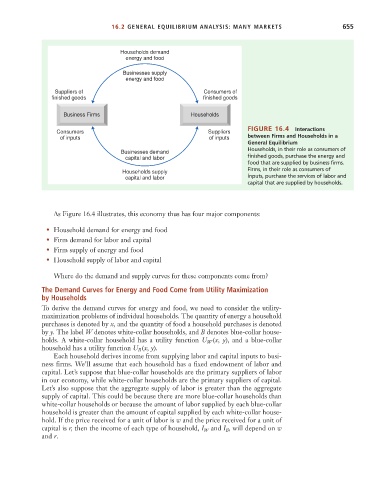Page 681 - Microeconomics, Fourth Edition
P. 681
c16GeneralEquilibriumTheory.qxd 8/16/10 9:13 PM Page 655
16.2 GENERAL EQUILIBRIUM ANALYSIS: MANY MARKETS 655
Households demand
energy and food
Businesses supply
energy and food
Suppliers of Consumers of
finished goods finished goods
Business Firms Households
FIGURE 16.4 Interactions
Consumers Suppliers
of inputs of inputs between Firms and Households in a
General Equilibrium
Households, in their role as consumers of
Businesses demand
capital and labor finished goods, purchase the energy and
food that are supplied by business firms.
Firms, in their role as consumers of
Households supply
capital and labor inputs, purchase the services of labor and
capital that are supplied by households.
As Figure 16.4 illustrates, this economy thus has four major components:
• Household demand for energy and food
• Firm demand for labor and capital
• Firm supply of energy and food
• Household supply of labor and capital
Where do the demand and supply curves for these components come from?
The Demand Curves for Energy and Food Come from Utility Maximization
by Households
To derive the demand curves for energy and food, we need to consider the utility-
maximization problems of individual households. The quantity of energy a household
purchases is denoted by x, and the quantity of food a household purchases is denoted
by y. The label W denotes white-collar households, and B denotes blue-collar house-
(x, y), and a blue-collar
holds. A white-collar household has a utility function U W
household has a utility function U (x, y).
B
Each household derives income from supplying labor and capital inputs to busi-
ness firms. We’ll assume that each household has a fixed endowment of labor and
capital. Let’s suppose that blue-collar households are the primary suppliers of labor
in our economy, while white-collar households are the primary suppliers of capital.
Let’s also suppose that the aggregate supply of labor is greater than the aggregate
supply of capital. This could be because there are more blue-collar households than
white-collar households or because the amount of labor supplied by each blue-collar
household is greater than the amount of capital supplied by each white-collar house-
hold. If the price received for a unit of labor is w and the price received for a unit of
capital is r, then the income of each type of household, I W and I , will depend on w
B
and r.

